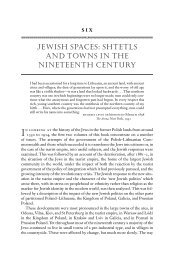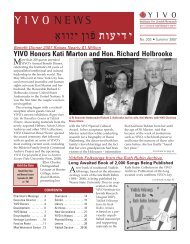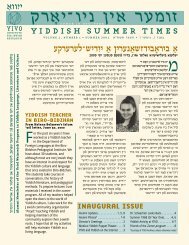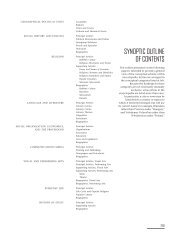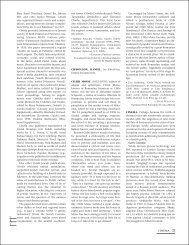t any plant names in Yiddish - YIVO Institute for Jewish Research
t any plant names in Yiddish - YIVO Institute for Jewish Research
t any plant names in Yiddish - YIVO Institute for Jewish Research
You also want an ePaper? Increase the reach of your titles
YUMPU automatically turns print PDFs into web optimized ePapers that Google loves.
XXX<br />
˘È„”È Ôȇ ËÏÚÂÂ≠ÔÒ˜ÈÂÂÚ‚ È„ Ÿ ¯ÚËÎÚ˘ È΄¯Ó<br />
lutski 1926-1933: 41), a fact that <strong>in</strong>spired the poet Sutskever (1963: 171) to<br />
term the tree krélboym.<br />
One of the favorite fruits of <strong>Yiddish</strong>-speak<strong>in</strong>g children is the fairly recent<br />
addition to the East European cul<strong>in</strong>ary repertoire known <strong>in</strong> English as<br />
the peanut. I cannot vouch <strong>for</strong> the <strong>Yiddish</strong>-speak<strong>in</strong>g children of Old Jerusalem,<br />
Antwerp, or the agricultural colonies of Argent<strong>in</strong>a, but I lov<strong>in</strong>gly recall<br />
a childhood game <strong>in</strong> Chernivtsy, Ukra<strong>in</strong>e (at that time: Cernăut¸i, Romania)<br />
that <strong>in</strong>cluded splitt<strong>in</strong>g open the peanut lengthwise and admir<strong>in</strong>g the result<strong>in</strong>g<br />
'figure' of a man with a flow<strong>in</strong>g, <strong>for</strong>ked beard clearly discernible, at<br />
least to a child's fertile imag<strong>in</strong>ation. Small wonder that <strong>Yiddish</strong>-speak<strong>in</strong>g<br />
children <strong>in</strong> various areas of Eastern Europe accord<strong>in</strong>gly co<strong>in</strong>ed such terms<br />
<strong>for</strong> the peanut as rébe-níslekh 'teacher/rabbi nuts' and móyshe-rabéynuníslekh<br />
'Moses the Lawgiver nuts'.<br />
Also probably rooted <strong>in</strong> children's language are kvítshers, fáyfelekh,<br />
(tíshebov-)bérshtlekh, tíshebov-kémelekh, tíshebovlekh, and other terms<br />
<strong>for</strong> 'burrs' (see the section on synonyms above).<br />
The 'flower generation'<br />
Twentieth-century <strong>Yiddish</strong> (especially s<strong>in</strong>ce the 1920s) could, with a<br />
little hyperbole, be called the 'flower century' or the 'flower generation'. For<br />
the first time the <strong>Yiddish</strong> speech community, its writers and poets and at<br />
least some of its speakers, discovered flowers and their beauty. In the preced<strong>in</strong>g<br />
centuries, talk<strong>in</strong>g about or admir<strong>in</strong>g flowers was considered bitlzman<br />
(a waste of time that should properly be devoted to the study of the<br />
Law). Sutskever and Shargel, Fridman and Shafir write lyrically about real<br />
flowers and co<strong>in</strong> <strong>names</strong> <strong>for</strong> imag<strong>in</strong>ary flowers. Hirshbeyn, <strong>in</strong> his travelogues,<br />
writes about the flower Makabéyer-blut (a calque from the Modern-<br />
Hebrew term <strong>for</strong> Helichrysum sangu<strong>in</strong>eum), as well as about tíger-lílye,<br />
shlángen-lílye, fóyglblum. Khil Falikman, a Bessarabian-born Soviet <strong>Yiddish</strong><br />
writer, mentions <strong>in</strong> one brief piece of his (1973) a dozen or so <strong>names</strong><br />
of flowers: shvártsbretlekh, zúnroyzn, pérl-blímelekh, nastúrtsyes, georgínes,<br />
matyóles, ástres, shnéygleklekh, etc.<br />
Even the gruesome Holocaust literature does not close its eyes to<br />
flowers – <strong>in</strong> one article about the destroyed <strong>Jewish</strong> community of Melave<br />
(M∏awa), the author, Dr. Zev Yunis (1950: 34-36) makes a po<strong>in</strong>t of list<strong>in</strong>g<br />
the flowers grow<strong>in</strong>g there: khábres, konkóles (typographical error <strong>for</strong> konvalyes?),<br />
mílekhblímelekh, lílyes, váser-lílyes, rezéde, bez, nastúrtsyes,<br />
levkóye, ástres, georgínes, royzn, oleánders, tábikblimen 'sunflowers'.<br />
One s<strong>in</strong>gle <strong>in</strong><strong>for</strong>mant, Mr. L. Iwier from Zhebye of eastern Galicia, rattled<br />
off to me 14 <strong>names</strong> of flowers as fluently as he would read them from<br />
a pr<strong>in</strong>ted list: bez, yasmín, georgínes, brátkes, shnéygleklekh, rezéde,<br />
margerítkes, royzn, málver royzn, konfitúr-royzn, górtnroyzn, téyroyzn, tulipánes,<br />
nákhtfaylkhn.



